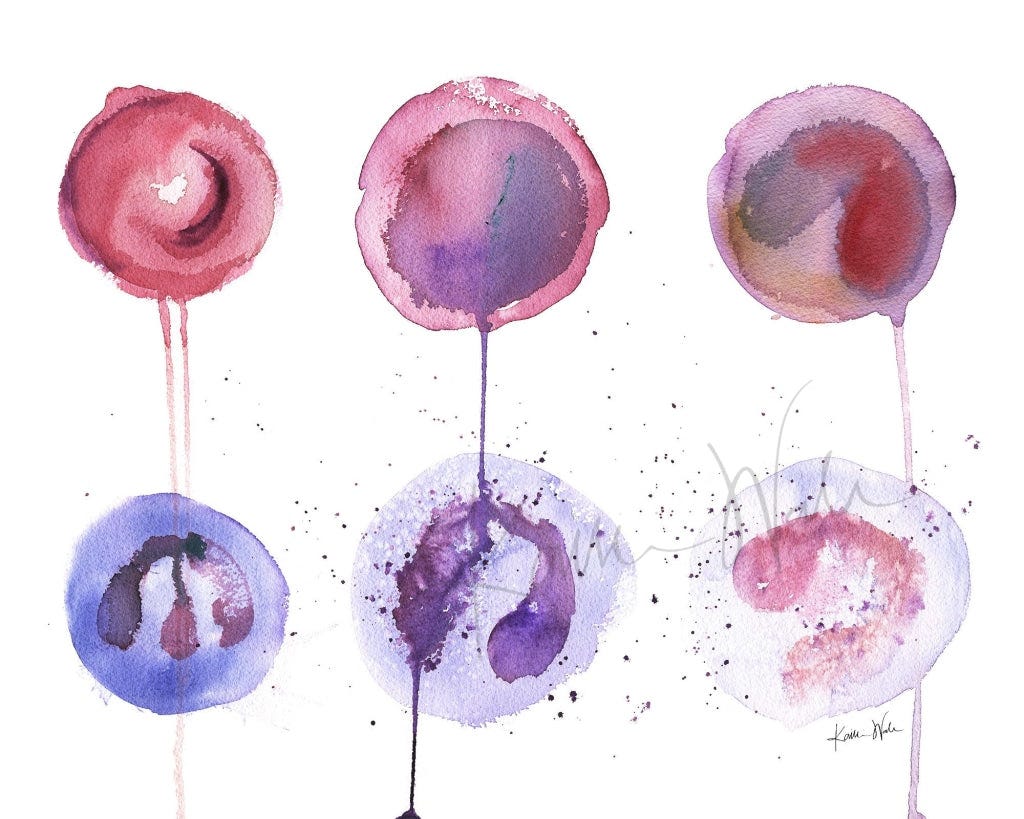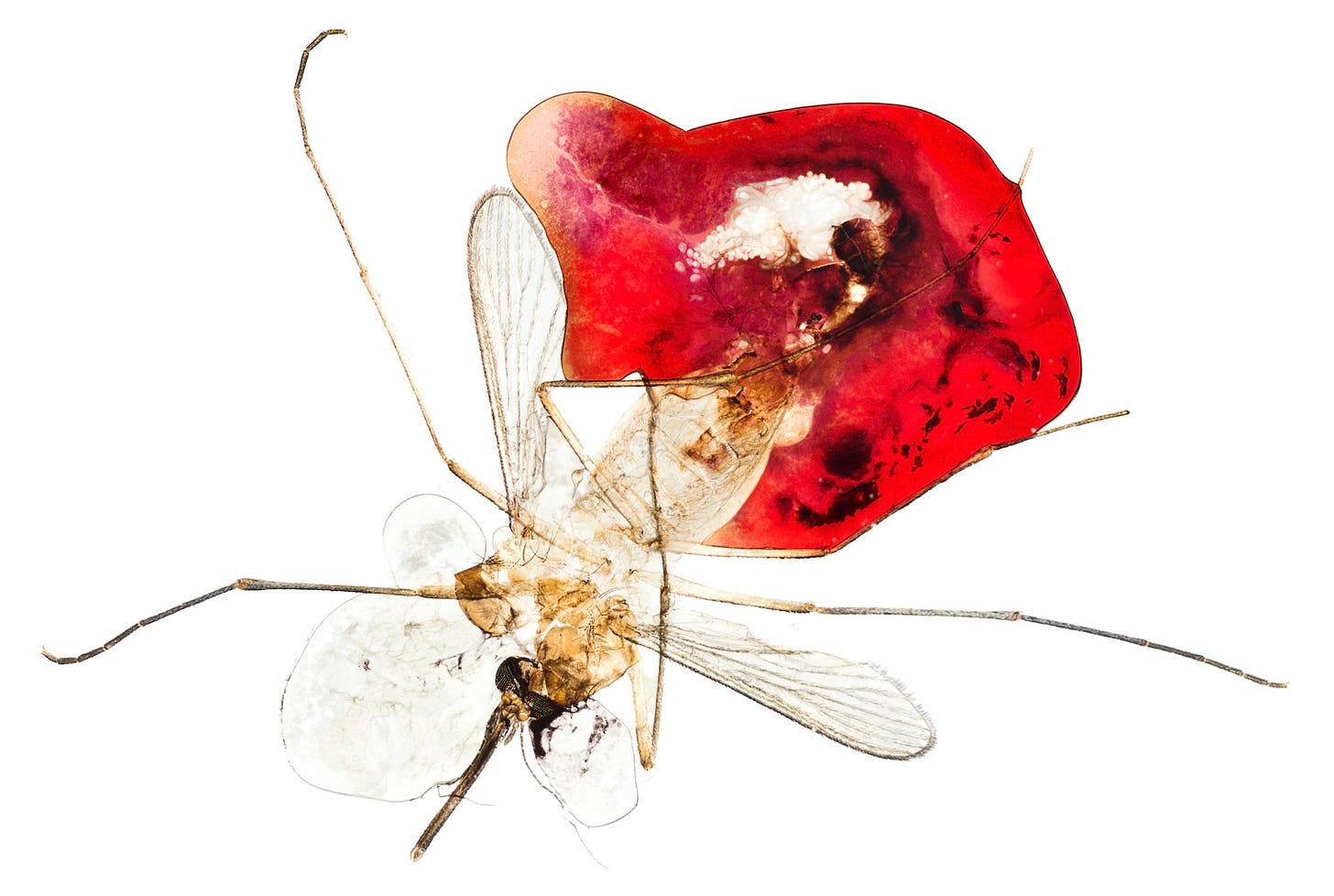#60: All They Can Drink Will Never Be Enough
“Our blood isn't the ideal blood, but … we're accessible. We're an easy blood meal."
While there’s some research that points to preferences for certain blood types (with my O+, the most common in Canada, being mildly favoured when compared to Type A), genetics, or a body’s ability to emit higher volumes of carbon dioxide and sweat, there’s no clear answer as to why black flies, horse flies, and mosquitoes find me so appealing.
The only thing I do know is that I am an entomological siren, with no control over my body as a beacon for the little vampires.

All manner of bug spray - whether it be natural/vegan/safe for kids variety, or the stuff of 1950s’ nuclear nightmares - does not work on me. Rather, it merely serves as a vinaigrette over the insects’ liquid meal. It starts with the black flies in the spring, then mosquitoes and horse flies - giant jumbo jets that leave quarter-size welts.
Slap. Sigh. I don the only saving grace I have, a $20 mosquito net that goes over my hat. It takes out the psychological aspect of being attacked, so I can squeeze out as much as I can from our all-too-short warm seasons.
Art is the farthest thing from my mind when I smack another foe. But in exploring SciArt, I’ve learned that science and art seems to intersect on every possible topic. For example, Jipil Jung uses macro photography to depict various mosquitoes who have fed on his blood, and then met their demise for both science and art. As part of his work, he shares facts about the blood suckers, such as the fact that only females who are laying eggs need others’ blood for successful reproduction.

There are other times, though, when my blood offering is willingly made, such as with a series of blood tests I got last summer. With one arm out splayed, resting on the cushioned arm rest, the phlebotomist inspects it with her gentle fingers before grabbing a thick rubber hose to cinch my arm.
I take a deep breath in, and then feel the pinch and dull ache.
The tubes - nine that day - fill quickly. Each has a distinct colour that denotes its special purpose: some allow clotting, others have chemicals like heparin, EDTA, or sodium citrate to prevent clotting. Each of these anticoagulants has effects on the blood cells, creating damage to certain cells that doesn’t matter for certain tests; or, alternatively, allowing the anticoagulant effects to be reversed easily with the addition of calcium once the analyst is ready to look at the samples.

The mosquitoes would love the gold tubes, which have a gel at the bottom to react with and separate the blood cells shown in Walsh’s watercolours from the “serum”: the liquid that carries these cells, but also plasma, chemicals and cells that help you clot, and proteins. It’s these proteins - the globulins throughout the blood serum, and the albumin in the blood plasma only - that the pesky mosquito needs to develop her eggs.
A rather humbling experience to realize that, despite our assumption that we’re at the top of the food chain, we’re still part of an insect’s Atkins diet.
Thirsty for More, Alucard?
The subheading quote comes from: Urquhart M. (2022 June 2.) Mosquito numbers have people buzzing in some parts of New Brunswick.
Blood Wars is a performance piece that takes volunteers’ blood and puts them in petri dishes to “fight” each other, with the victor moving on to the next challenger.
Kim Morgan depicts endless galaxies under her scanning electron microscope that constantly run through the complex architecture that makes up our circulatory systems.
Kids learned about blood before making educational postcards in Emily Dustman’s course on human diseases.






The headpiece looks very effective, but I note that Rebecca mentions midges in the comments. The net, I'm afraid is porous to those little things.
I used to trek through the Boundary Waters Canoe Area and cross the Canadian border in the lakes and portages. The mosquitos in that region are humongous. Minnesota's mock state bird is the mosquito, by the way, though the buggers are rivaled in size to their cousins in south Florida's Everglades. Get too many of them on you and they'll fly off with you!
Absolutely fascinating, Bryn - I learned so much! I'm sorry to hear that you're a martyr to mosquitoes and their bitey buddies. We both got horribly bitten by midges a couple of summers ago when we camped too close to a river (no alternative: the campsite's location beside the river meant we had no option - LOL!). I don't think in general I get bitten any more than the general population, though, so I'm pretty grateful for that.
I had no idea that blood vials are filled in a particular order - that's really interesting. I'll pay particular attention next time I go and see the vampires!